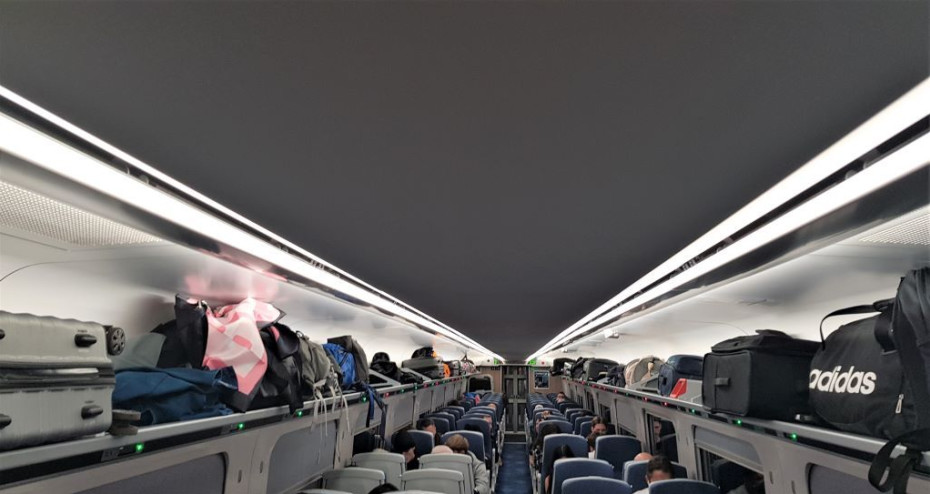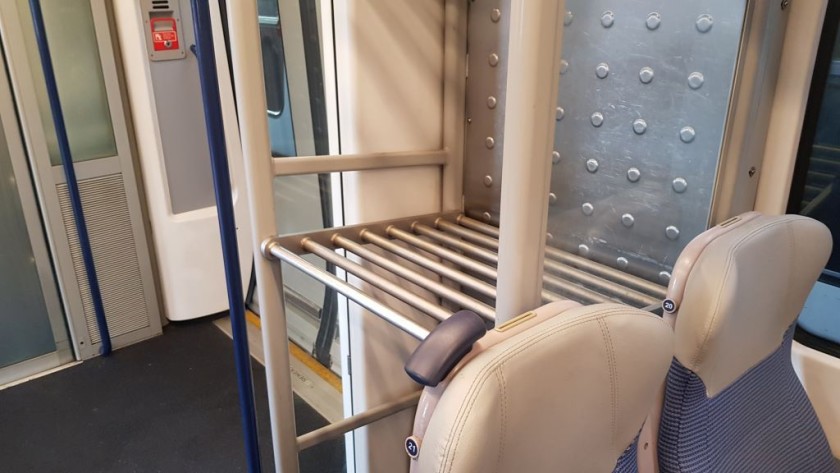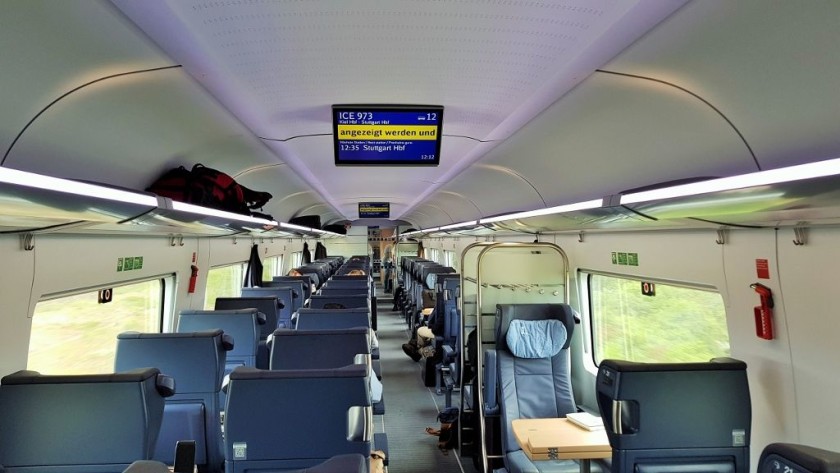Related Content
Content

Managing Luggage on European Train Journeys
If you'll need to travel with heavy luggage when travelling by trains, these tips derived from taking a medium sized bag to more than 80 cities, should be a help!
Share
An often overlooked positive of choosing trains over planes for a holiday travel option is the avoidance of the anxious wait at a carousel, while you ponder whether you will be reunited with your bags.
On the flip side is the potential negative of having to manage the transportation of your luggage during the entire end-to-end journey.
That's because European daytime trains aren’t designed around the needs of holiday makers, as the majority of their annual passengers are going somewhere and back in a single day.
Also specific trains aren’t usually allocated on routes to beaches and ski resorts and providing as many seats as possible wins out over luggage space on the train operator’s priority list.
So if you need to take a week or more’s possessions with you, boarding with, and storing larger items of luggage on trains can occasionally be a tad awkward, especially when travelling on Friday and Sunday afternoons year round and on summer Saturdays.
When available, spaces for suitcases and rucksacks can’t ever be reserved on the trains; also dedicated luggage vans on trains are now rare, though they are fairly common in Czechia.
So here are nine tips and ideas to make the taking of a train journey a little easier. when you're weighed down.
Size and weight:
Thankfully dedicated luggage racks with shelves are becoming more common on European long-distance trains, but they are hardly ever capable of storing larger sized items.
Due to a last-minute malfunction with my preferred bag, I travelled on my most recent multi-train travel adventure with a suitcase which was 65cm tall and 40cm wide, so it was larger than that which I normally take and whether it was stored horizontally or vertically, it was a tight fit on all the luggage racks I used.
I ordinarily wouldn’t have needed such a large bag with me, so a top tip is to squeeze everything you need into the smallest possible bag that you can get away with.
The main reason why this is a good idea is that the overwhelming majority of the luggage storage space on European express trains is in the luggage racks which are fitted above the windows.
They are similar too, but less roomy, than the overhead luggage bins on airlines.
Though typically those max size items of luggage which airlines permit within the cabin, will also fit into these spaces on the trains.
So thinking, ‘oh I’m going by train, so I can forget about all those luggage rules’ is best avoided, because taking bags on trains which will ‘fit’ into these overhead racks is much less stressful than taking bags which are too large to be placed there.
And yes some specific sizes and dimensions would be welcome here, but (1) the sizes of luggage racks can vary between types of train; and (2) the train operating companies often don’t make this info available; though the German national rail operator DB states that its type of of luggage racks fixed to the floor, measure 700 x 500 x 300 mm.
So as the overhead luggage racks are the easier option, also consider the weight of the bag.
Before leaving home test it to discover if you can easily lift it above your head.
If you can’t, then think about splitting it into two smaller bags, so that you can lighten the load per bag.
Luggage allowances
On some European train services limits are set for the maximum number of items, which can be transported by each passenger; the key 'rules' worth being particularly aware of are:
Eurostar trains
When travelling Standard Class = 1 item of hand luggage (handbag, briefcase, computer bag, etc.) + 2 bags or cases (not exceeding 85 cm in length)
When travelling Premier Class / Standard Premier Class = 1 item or hand luggage + 3 bags or cases (max. 85 cm in length)
Children's allowance = 1 item of hand luggage + 1 bag or case (max. 85 cm in length)
Ouigo Trains
The price of your ticket includes one of two luggage options:
- two pieces of hand luggage up to 36 cm high x 27 cm wide x 15 cm deep
- one piece of hand luggage (up to 36 cm high x 27 cm wide x 15 cm deep) and one carryon bag (up to 55 cm high x 35 cm wide x 25 cm deep)
Thalys trains (Paris ↔ Bruxelles - Antwerp -Rotterdam - Amsterdam; and Paris ↔ Bruxelles - Liege - Cologne - Dusseldorf - Dortmund)
1 item of hand luggage + max. 2 items of luggage (max. dimensions 75 x 53 x 30 cm)
Weight may not exceed 32 kg per item of luggage and overall dimensions (length + width + height) may not be more than 158 cm per item of luggage.
In Poland on the EIC and EIP and IC express trains you need to pay a surcharge of 10PL if your luggage won't fit in a luggage rack, in the overhead storage or under a seat.
In Spain the maximum allowance set by the national rail operator Renfe is no more than 3 baggage items; each piece of luggage does not exceed 85 cm x 55 cm x 35 cm.
The total weight of the 3 baggage items must not exceed 25 kg and the length 290 cm.
In Sweden, on trains operated by the national rail operator SJ is a maximum of two bags (size 80x50x35 cm and 20kg) and a smaller hand luggage.
You may also bring a special luggage such as a folded stroller or a ski case.
Split it:

Two x smaller (carry on size) bags/cases is usually a better option than one medium bag, because you’ll be much more likely to be able to fit them into those spaces above the windows.
Even if a medium sized bag will fit into one of these racks, it's likely it will be too heavy to maneuver into position, because you’ll need to stretch to reach the rack.
Taking 1 x a smaller bag + 1 x medium sized bag is definitely a better option than travelling with one large bag / case / rucksack etc.
Large bags, particularly suitcases, won’t fit easily on to the type of dedicated luggage racks which are fixed to the floor, or on the luggage storage shelves which are available on some trains.
Larger bags also typically can’t be left in the aisles, corridors or by the doors if you can't find space, which equals a problem.
Also on the ‘no’ or ‘please don’t’ travel rules is the storing large items of luggage in the spaces on the train which are dedicated to wheelchair users or for bicycles.
So splitting luggage into two smaller bags/suitcases instead of one large bag can make the taking of journeys so much easier.
You might be thinking ‘how am I supposed to wheel two or more bags around a station?'
Well here’s a very handy guide on how to solve this conundrum, which involves stacking a smaller bag on top of a medium sized bag, so that they can be pulled around together.
In addition to making the bags easier to stow on the train, a quick snap of a tag or strap, so that you can then board a train with a bag in each hand, instead of having to heave one heavier bag through a train door can be a lot less awkward.
When on my longer multi-destination trips, such as following a rail pass itinerary, I take four bags with me:
- A medium-sized wheeled suitcase, in which I place the items I won't need at my next couple of destinations.
- A carry-on size bag, which can be stacked on top of the suitcase.
- A small back-pack which I can use for days when I won't be taking the train, which will fit inside the suitcase.
- An over the shoulder pack in which I can store my travel documents etc, so that I can have easy access to them at ticket barriers etc.
There’s also another very good reason for splitting your luggage across more than one bag, which is in the advice below for using left-luggage offices.
Be early at the station:
Rushing through a station to catch a train obviously isn’t conducive to stress-free train travel, but doing it with luggage can be a risky endeavor.
If you will be boarding a train at its starting point, then being at the station so that you can be there when the departure details such as the track / platform number are confirmed, can be a big plus.
If you’ll have luggage with you that’s too large or heavy to be placed in the above seat luggage racks on train, you could be in a scenario in which your competing with your fellow passengers for the easier storage space on the larger luggage racks.
So if you can join the race when the starting gun is fired, you can win out by easily finding space on the train.
Doing your utmost to ensure that your among the first to board can seem a tad extreme, my father was a tad obsessed with this on family holidays, but I can now fully appreciate why we were always at the station an hour before the departure time.
Elevators at stations:
SMTJ always strives to point out whether a station is a terminus, because at most of these stations the platforms/tracks that the trains use and the concourse, where you’ll find access to and from taxi ranks and entrance to metro stations etc, is all on one level.
Which among other things, makes it easier to maneuver wheeled luggage around such stations; which include the likes of King’s Cross, Paddington and Victoria in London; Gare de I’Est, Gare De Lyon and St-Lazare in Paris; plus Paris Nord when not departing by Eurostar; and Firenze SMN, Frankfurt (Main), Glasgow Central, Goteborg C, Munchen hbf, Napoli Centrale, Malaga, Marseille-St Charles, Roma Termini and Venezia S.Lucia.
Though a few terminus stations including London St Pancras International, Madrid-Atocha and Charmartin, Milano Centrale and Paris Montparnasse are on multiple levels; there are always multiple exceptions to every ‘rule’ when travelling on European trains.
But at other stations the access to and from most or all of the trains is by using stairs, escalators or lifts /elevators.
Aside from those four stations mentioned above, other busy stations where this is the case include: Amsterdam Central, Basel SBB, Berlin Hbf, Bern, Birmingham New St, Bologna, Bruxelles Midi, Edinburgh Waverley, Geneve, Genova-Piazza Principe, Hamburg Hbf, Kobenhavn H, Koln Hbf, Wien Hbf and York.
In such stations if you will be travelling with bags too heavy to be easily conveyed up and down staircases, seeking out the elevators can be a less-risky scenario than trying to balance bags on escalators.
Though using the lifts (elevators) can often involve having to go the long-way round, or seeking them out on a less obvious route through the station.
So if you’ll be in this scenario, get to the station earlier than you otherwise would have done, so that you can take your time in planning how you'll make your way to the train.
Spending an extra 5 mins to get to/from a platform/track, can pay off in terms of the stress you'll save.
When changing trains, if you’ll want to make use elevators to transport luggage, try to avoid connections between trains of less than 10-15 min.
The elevator/lift can be some distance away at the opposite end of a platform/track and you may have to queue to use it, so this can easily add 10 minutes to a transfer time.
Wheeling your bags into a station café or bar and then taking the next train, can be the better way to go.
First Class can be easier:

If I’m going to be taking a medium sized bag with me long-distance on an express train; I then try track to track down the cheapest First Class ticket I can find for a train journey.
If I’m going to be travelling with other people, who’ll also have medium sized cases with them, I’m willing to travel up to a couple of hours earlier or later than I otherwise would have done, if I can find a good price in First / Premier Class.
Why? It’s because on the trains used for many daytime express services, such as ICE, Frecce, Railjet, TGV, IETs, Azumas and Pendolinos there’s typically more space in which to store medium (or large) bags when travelling First Class compared to Second / Standard Class.
Fewer seats need to be squeezed in, so more luggage racks of the type which are fixed to the floor, are typically provided in first class coaches, so you'll often find that there are additional luggage racks available in the middle of the seating saloons.
However, more crucially, the seats have additional space between them, so this usually provides additional less obvious space, plus there's also more room in which to maneuver medium sized bags into available spaces than in Standard Class.
Meaning that medium sized bags can usually also be placed between or even under the seats; and this is more rarely an option in Standard Class seating saloons.
Also the fewer the number of seats in the coach /carriage means fewer fellow travelers, so there's less competition for the storage space.
More than the larger seats, at seat service, the food, the drink and all of the other typical First-Class benefits, it’s the additional luggage space which most often leads me to booking First Class tickets.
Though note that I’ve singled out express trains for this nugget of advice, because on regional and commuter trains there often isn’t any additional luggage space in First Class.
Be smart when boarding:
This tip came from experience because when boarding a busy train when it calls at a station during its journey, it can seem obvious to prioritise finding an available seat if you don’t have a reservation, or finding your seat when you do have one.
You can almost forget that your carrying a fairly heavy bag as you rush into the seating saloon area.
But the majority of the storage space for larger items of luggage will be by the entrance to the seating area, usually on the other side of the sliding door, but they can be in a space outside the seating saloon.
So if you have a medium or large sized bag with you, instead of finding a seat(s) make your initial priority checking whether you can find space on the luggage racks / shelves by these doors.
Avoid a scenario in which you’ve taken your bag into the middle of the seating area to then belatedly discover that there’s nowhere by your seat(s) to store it;
You'll then want to reverse direction and head back to the luggage rack, but the passengers behind you will now be unwittingly blocking your path and filling up what was the space on the rack.
So my golden rule is to look for space in the luggage storage area and then find your assigned seat, or an available seat.
Unless your fellow travelers are particularly rude, it’s likely that nobody else will be able to push by you, while you’re storing you bag.
Also don’t be afraid of playing a game of luggage Jenga.
If you’re left thinking ‘if I could just turn that bag around or bring it forward, then mine would fit too’ then do it. More often than not the owner of the other item of luggage will see what you’re doing and come and help you.
But if you need to move bags to a different shelf to get yours to fit, don’t be afraid to call out; “Excuse me, who does this Blue Samsonite suitcase belong to” etc.
If when you've taken your seat(s) you’re not comfortable that you can’t see your bags from where you are, once everyone else has settled down, you might be able to move seats, or move the bag.
Also if you do have a reserved seat, the seat numbers closest to a door will often be on the outside of the train, so if you use them to target the optimum door when boarding, it can make getting on the train with luggage a much simpler scenario.
Avoid using the metro: take a bus or tram:
Metro systems and luggage aren’t particularly compatible, aside from a few metro lines which serve airports, the trains don’t have luggage storage space.
If you will be taking a metro to a city centre station between 08:00 and 09:00 or away from one between 16:30 and 18:30, you’ll likely have trouble squeezing yourself on to a train, so medium sized bags can be a problem.
Also elevator connections between a station concourse and where the metro trains arrive and depart from are rare.
The primary access to and from the metro trains will usually be by escalators; and taking larger bags on to escalators can be a risky element of a rail journey.
Also away from the Metro stops which serve the mainline stations, you may have to use stairs to access the street even if escalators or lifts (elevators) are available from/to the trains.
So if you don’t want to take a taxi, taking a bus or tram from and to the station instead of a metro can be an option worth exploring.
It’s why the station pages on SMTJ have links to onward journey planners and public transport maps, plus links to locations on Google Maps, which also show the bus/tram stops.
Planning a route by bus and tram between a station and ultimate start or end point, can involve diving into multiple resources, but it can pay off.
Boarding with bags on to buses or trams is a lot less awkward than taking the metro with luggage, also many buses now have luggage storage space
You also probably won't need to rush to your overnight accommodation, so the fact that taking the bus or tram will be slower won't matter and you’ll also likely save money too.
Amsterdam Centraal; Berlin Hbf, Budapest Nyugati, Lyon-Part-Dieu, London Euston, London Victoria, Marseille-St Charles, Paris Montparnasse, Praha-Hoselvice and Roma Termini are stations served by metros, which also have immediately adjacent tram stops and/or multi-route bus stations.
In Paris, bus line/route 91 links the major stations
In London bus routes/lines 46, 63, 261 to areas of the city centre, stop on the same block as St Pancras International station on Midland Road and just in front of King’s Cross station.
Plus taking the Thameslink trains between London Bridge and St Pancras (for King’s Cross) is a more luggage friendly alternative to taking the Northern Line.
Maximise the left luggage opportunities:
Another plus of dividing luggage into multiple smaller bags is that it gives you the option to be smart when using a left luggage facility.
If you’re following a multi-destination itinerary, split your luggage into what you will and won’t need when you reach other destinations.
Take with you the the smaller sized bag you’ll need for your stay in that city and leave everything else in a left luggage office, so that you can collect it when you’re back at the station for your next journey.
You won’t then be so burdened with luggage when making the transfers between the station and your accommodation.
Also look out for opportunities to leave your heavier bags in left luggage offices when you’re following more complicated itineraries.
Being able to travel on to multiple destinations without the burden of having to take your heaviest and largest bag with you on every stage of your journey, can be a winner!
I have left a heavy bag behind me for 6 days in Barcelona, so that I didn’t have to take my larger item of luggage on the Valencia → Madrid → Barcelona part of my trip.
I also once made a three hour detour to collect a bag I’d left at Milano Centrale, so that I could have easier journeys to Venice then on to Rome and Naples; and concluded it was a smart decision.
Forward your luggage for ultimate convenience:
If you think that completely avoiding having to travel your luggage when taking a train is a service worth paying for, some European train operators offer luggage forwarding services.
In Austria with OBB; its luggage service can transport luggage between addresses in Austria and can also deliver luggage to Switzerland and south-east Germany.
Eurostar partners with First Luggage to offer a luggage delivery service.
SNCF in France offers the Mes Bagages service.
In Germany, the national operator DB has partnered with Hermes
In Italy, the national train operator Trenitalia has partnered with TNT.
In Switzerland the national operator SBB offers a door-to-door service and a station-to-station service.
Please support ShowMeTheJourney
This second version of ShowMeTheJourney is exciting and new, so we are genuinely thrilled that you are here and reading this, but we also need your help.
We’re striving not to let anything get in the way of providing the most useful service possible, hence a facility has been set up with DonorBox which can be used to support the running costs and make improvements.
Instead of advertising or paywalls, your financial support will make a positive difference to delivering an enhanced service, as there’s a lot of ideas which we want to make happen.
So if you have found the info provided here to be useful, please go here to say thank you.

Simon Harper
I wanted to share my passion for train travel and explain how anyone can take the fantastic journeys I have taken.

This is one of more than 100 train travel guides available on ShowMeTheJourney, which will make it easier to take the train journeys you want or need to make. As always, all images were captured on trips taken by ShowMeTheJourney.
This second version of ShowMeTheJourney is exciting and new, so we are genuinely thrilled that you are here and reading this, but we also need your help.
We’re striving not to let anything get in the way of providing the most useful service possible, hence a facility has been set up with DonorBox which can be used to support the running costs and make improvements.
Instead of advertising or paywalls, your financial support will make a positive difference to delivering an enhanced service, as there’s a lot of ideas which we want to make happen.
So if you have found the info provided here to be useful, please consider saying thank you.






